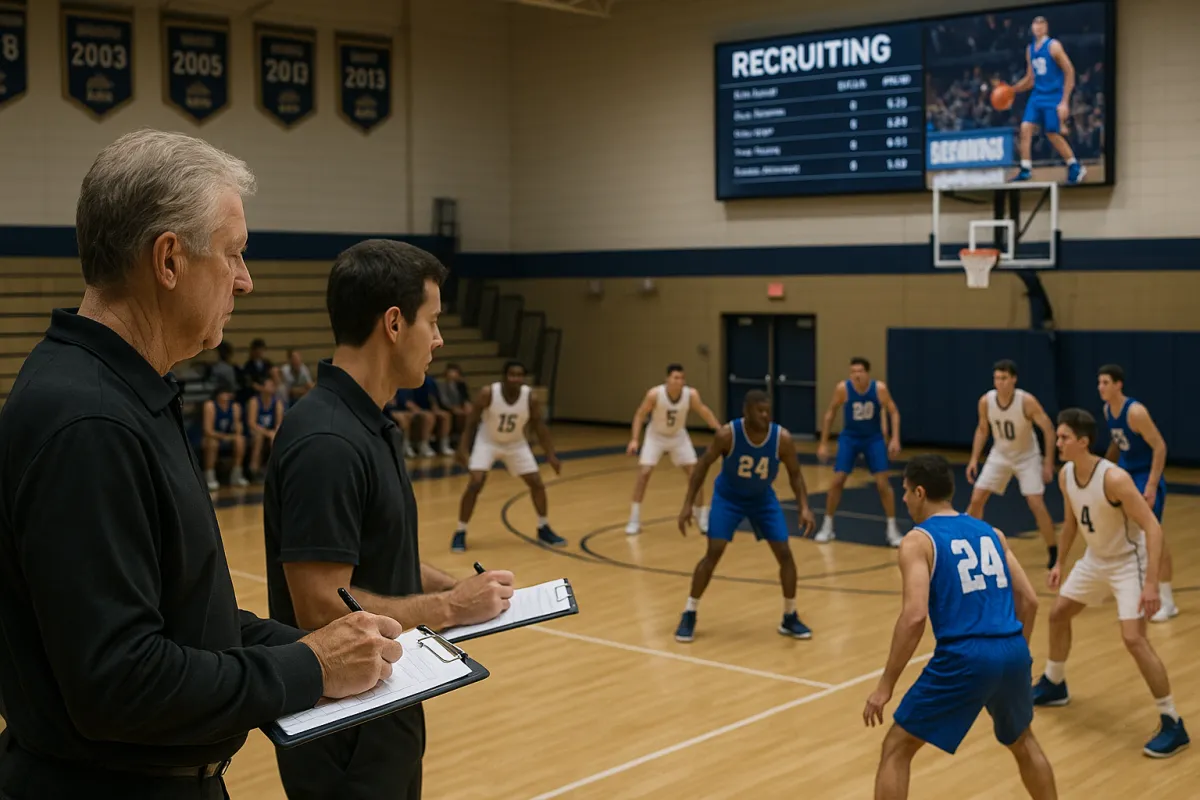
Playing Zone vs Man to Man in the Recruiting Process
Playing Zone vs Man to Man in the Recruiting Process
Recruiting is a game of strategy where every move matters and attention to detail separates contenders from pretenders. The decision between playing zone defense or man to man in the recruiting process shapes not only the outcome for athletes and coaches but also the entire dynamic of talent discovery. This article breaks down the strengths, risks, and actionable tactics behind each approach, giving athletes, parents, and coaches a clear playbook for maximizing opportunities and minimizing mistakes in a high-stakes arena.
Defining Zone Defense and Man to Man in Recruiting
Zone defense in recruiting means casting a wide net. Coaches and recruiters focus on general areas, schools, or demographics, targeting groups rather than individuals. This method resembles covering a region on the court, watching for talent to emerge anywhere inside the boundaries. Man to man recruiting, on the other hand, is highly personalized. Each recruiter or coach takes direct responsibility for a specific athlete, building a relationship, tracking progress, and tailoring communication to that recruit’s journey.
Zone defense attracts programs with limited resources or those needing to fill multiple positions quickly. It values efficiency and reach, often leveraging digital tools, recruiting platforms, and database-driven searches to scout many prospects simultaneously. Man to man shines when programs seek high-impact players or face intense competition for elite talent. This approach demands time, persistence, and a deep understanding of each recruit’s aspirations and challenges.
Understanding these recruiting philosophies lays the foundation for choosing the right method. Coaches often blend both, but knowing when to shift gears can mean the difference between landing a program-changer and missing out altogether.
Zone Defense Recruiting Tactics: Casting the Net Wide
Zone defense recruiting thrives on breadth. Coaches and recruiters use regional showcases, digital scouting services, and mass communications to identify a pool of potential candidates. The process typically begins with large group emails, general invitations to events, or outreach through high school and club coaches. This approach creates visibility for the program and allows it to monitor a variety of prospects without heavy time investment in any single individual.
Modern technology amplifies the reach of zone defense tactics. Social media monitoring, video analysis platforms, and online recruiting databases allow recruiters to scan thousands of athletes for basic fit. Automated messaging and standardized questionnaires streamline early communication, helping programs filter the pool before moving to more targeted engagement.
Zone defense works best for programs rebuilding rosters, managing high turnover, or seeking to maintain a steady pipeline of talent. The process relies on efficient systems and a willingness to let some prospects slip through the cracks in order to maximize the chance of finding hidden gems.
Man to Man Recruiting: The Power of Personalization
Man to man recruiting requires full engagement. Coaches or recruiters assign themselves to specific athletes, building trust through consistent, individualized communication. They attend games in person, connect with families, and invest time in understanding each recruit’s goals beyond the court or field. This approach signals genuine interest and often resonates with high-level prospects who crave attention and detailed feedback.
Personalization is the core advantage of man to man recruiting. Handwritten notes, tailored campus visits, and direct involvement from head coaches separate serious suitors from background noise. Athletes in this process often feel valued, leading to stronger commitments and reduced risk of last-minute changes of heart. Programs that excel at man to man recruiting create a reputation for loyalty and follow-through, which attracts future waves of talent.
Man to man strategies require more staff hours and a higher emotional investment. Coaches must balance their time and energy, ensuring they can deliver on promises made to each recruit. Programs that overextend risk burning out staff or losing focus on other roster needs.
Strengths of Zone Defense Recruiting
Zone defense recruiting brings several key advantages to athletic programs, especially those operating with limited resources or broad roster needs. Its efficiency enables coaches to reach a vast audience with minimal effort, often uncovering talent that might go unnoticed in a more personalized approach. The scalability provided by digital tools and mass communication platforms ensures that even small programs can compete for emerging prospects on a larger stage.
Key strengths include:
High volume outreach with limited staff
Ability to discover late bloomers or overlooked athletes
Systematic tracking of responses and interest levels
Reduced risk of missing out on groups or regions due to narrow focus
Zone defense also fosters resilience against sudden changes in roster needs. Coaches can quickly pivot to different segments of the talent pool if a position unexpectedly opens. The approach supports long-term program building by keeping the recruiting funnel full and flexible.
Challenges of Zone Defense in the Recruiting Process
Zone defense recruiting can produce a flood of data but limited depth. Prospects may feel like numbers rather than valued individuals, which can cost a program its chance at signing a high-impact athlete. Automated messages and group invitations lack the personal touch that top recruits often expect, and competition from programs using man to man tactics can erode trust or interest.
Other challenges include:
Difficulty tracking nuanced changes in a recruit’s situation or attitude
Risk of missing red flags or unique qualities that only surface with close observation
Potential for communication errors or mixed messages across a large pool
Limited feedback for prospects, leading to confusion or disengagement
Programs relying too heavily on zone defense may struggle to close deals with elite prospects. They need strong systems for moving promising recruits from the general pool into more personalized attention as interest grows.
Man to Man Recruiting Advantages: Building Loyalty and Fit
Man to man recruiting builds lasting relationships. Athletes who receive direct attention develop a sense of loyalty and belonging, which can influence their final decision even when other programs offer similar scholarships or resources. Programs that prioritize fit and culture find greater long-term success with this method, as recruits are more likely to thrive and remain committed throughout their careers.
Advantages include:
Deeper understanding of a recruit’s motivations, strengths, and challenges
Ability to tailor offers, visits, and communication for maximum impact
Higher conversion rates from interest to commitment
Better alignment between athlete personality and program culture
Man to man recruiting also supports retention. Athletes who feel seen and heard before committing are less likely to transfer or quit when adversity strikes. This strategy creates a feedback loop of positive outcomes and word-of-mouth referrals.
When to Use Zone Defense vs Man to Man in Recruiting
Timing and context drive the choice between zone defense and man to man recruiting. Programs launching a new team or facing large-scale roster turnover benefit from the reach and speed of zone defense. During the early phases of recruitment, casting a wide net helps identify prospects who might otherwise be missed. Coaches can then transition top prospects into a man to man strategy as relationships mature.
Man to man tactics shine during critical decision-making windows. Coaches should engage directly with priority recruits during campus visits, scholarship negotiations, and late-stage conversations. This approach also works well for highly specialized positions or when competing for a small pool of elite talent.
Blending both methods, programs create a pipeline that starts broad and narrows to high-impact, personalized engagement. The ability to shift gears at the right moment defines successful recruiters and sets winning programs apart.
Actionable Steps for Coaches and Recruiters
Executing an effective recruiting process requires a clear plan. Coaches and recruiters can follow these steps to maximize results:
Start with zone defense: Build a broad prospect pool using digital scouting, showcases, and mass communication.
Segment prospects: Use data and feedback to identify those showing real interest or unique potential.
Transition to man to man: Assign staff to high-priority recruits for personalized engagement.
Track interactions: Maintain detailed records of conversations, visits, and key milestones.
Review and adjust: Regularly evaluate results and shift resources as needed to close on top targets.
This structured approach helps programs avoid common pitfalls and ensures no valuable prospect goes unnoticed or feels neglected.
What Athletes and Families Need to Know
Athletes and their families play a crucial role in shaping their own recruiting journeys. Recognizing the signs of zone defense and man to man approaches allows them to respond strategically and advocate for themselves. When receiving group emails or generic invitations, athletes should follow up with personalized content such as highlight videos, academic achievements, and clear communication of goals.
During personalized engagement, honesty and consistency matter. Athletes should keep coaches informed of changes in interest or circumstances and use direct communication to build trust. Families can support by helping organize schedules, preparing questions for coaches, and researching program fit beyond athletics, academics, campus culture, and post-graduation support all matter.
Taking an active role empowers athletes to navigate the process instead of feeling swept along. Resources such as the Role Player Guide to Recruiting and the FTP Information Portal offer more insights for families seeking an edge.
Common Mistakes When Choosing a Recruiting Strategy
Choosing between zone defense and man to man in recruiting presents several traps for coaches and athletes. Programs that rush to personalize every interaction often burn out resources or set unrealistic expectations they cannot meet for every prospect. Relying too heavily on zone tactics can make a program appear disinterested or disorganized, costing them top talent.
Athletes sometimes misinterpret a zone defense approach as lack of interest, failing to respond or provide additional information. Others may focus only on programs giving intense personal attention, overlooking better overall fits found through broader outreach. The key is self-awareness and adaptability, knowing when to push for more engagement and when to let the process unfold naturally.
Staying organized and focused on long-term goals, rather than short-term attention, helps both coaches and athletes avoid these pitfalls. Regularly reviewing progress and seeking feedback ensures the process remains on track.
Recruiting in a Digital Age: Technology’s Role
Digital innovation shapes every aspect of modern recruiting. Video analysis platforms, recruiting databases, and social media monitoring tools empower coaches to execute zone defense at scale. Automated workflows keep communication flowing even with large prospect pools, while analytics dashboards help identify emerging trends and high-potential prospects.
Technology also enhances man to man recruiting. Personalized video calls, real-time messaging, and virtual campus tours allow coaches to build trust with recruits who may live thousands of miles away. Families use these tools to evaluate programs, ask detailed questions, and track communication history.
Digital tools do not replace the human element but amplify its reach. Programs that integrate technology with authentic relationship-building set themselves up for sustained recruiting success. Athletes who leverage digital platforms to showcase their skills and communicate proactively increase their visibility and appeal.
The Future of Recruiting: Adaptability Wins
Recruiting never stays static and neither do the strategies that drive success. Programs that master both zone defense and man to man approaches adapt quickly to shifting needs, unexpected roster changes, and evolving prospect expectations. Athletes and families who understand these methods gain confidence and control over their journey, using each interaction as a stepping stone toward the right fit.
Staying informed, flexible, and proactive defines the new era of recruiting. Those who treat every phase as an opportunity to build relationships, gather information, and refine their approach will find themselves ahead of the curve. For more on keeping pace with modern recruiting, check out the College Recruiting Process vs the Microwave vs the Air Fryer and other resources at Facilitate The Process Blog.
Winning the Recruiting Game: Perspective That Sticks
Every recruiting journey is a test of patience, strategy, and adaptability. Those who thrive recognize that both zone defense and man to man approaches have a place in the process. Mastering when to spread the net and when to focus on one prospect is a skill that pays dividends for years. Coaches, athletes, and families willing to learn, pivot, and invest in real relationships become the ones telling the stories that inspire the next generation of recruits.
Frequently Asked Questions
What is the main difference between zone defense and man to man in recruiting?
Zone defense targets groups or regions, using broad communication and digital tools. Man to man assigns specific staff to individual prospects for personalized engagement and relationship building.
How can athletes stand out in a zone defense recruiting approach?
Athletes can follow up with personalized communication, share highlight videos, and provide academic and extracurricular information to move from the general pool to targeted attention.
When should a program switch from zone defense to man to man recruiting?
The transition happens after identifying high-potential prospects or when a recruit shows strong interest and fit. Personalized engagement then helps close the commitment.
What are common mistakes in the recruiting process for both coaches and athletes?
Overpersonalizing too early can burn resources, while relying only on zone tactics can lose top talent. Athletes may misinterpret generic outreach or focus only on attention rather than fit.
How does technology impact recruiting strategies today?
Technology enables efficient zone defense through databases and automation, while also supporting man to man engagement with video calls and real-time messaging, amplifying both reach and personalization.





